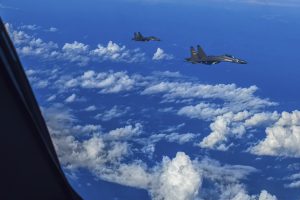Narantsatsral Enkhbat

In this photo released by Xinhua News Agency, fighter jets of the Eastern Theater Command of the Chinese People’s Liberation Army (PLA) conduct a joint combat training exercises around the Taiwan Island on Sunday, Aug. 7, 2022.Credit: Gong Yulong/Xinhua via AP
China today is rapidly building up its military, aiming to become strong enough to protect its interests, and presumably to surpass its biggest competitor – the United States. Chinese President Xi Jinping, soon after he took power, announced a drastic military reform program, modernizing weapons and technology and improving the People’s Liberation Army (PLA)’s organization, training, and preparedness. The goal is to “basically complete the modernization of national defense and the military by 2035 and to fully transform the people’s armed forces into world-class forces by the mid-21st century.”
As part of the modernization plan to advance combat readiness and preparedness, the PLA has intensified and increased its military exercises. Beijing uses military exercises for a wide variety of reasons, from military training purposes (improving quality of military performances and testing new weapons) to political and strategic ends. However, the politico-strategic dimensions of Chinese military exercises are frequently overlooked, which can have far-reaching consequences for regional and global security.
In particular, China is employing military exercises as a tool to demonstrate its military might and signal its willingness and ability to “reunify” Taiwan. The use of military exercises by China to intimidate Taiwan through displays of military prowess is not a new phenomenon. Such exercises often serve as a scare tactic to remind Taiwan of the potential consequences of drawing closer to the United States. “Those who play with fire will perish by it,” Chinese President Xi Jinping warned during a telephone conversation with U.S. President Joe Biden last year. Such warnings often emphasize China’s determination to oppose any actions that could be interpreted as supporting Taiwanese independence as well as threatening China`s security.
The degree to which China perceives a certain action by the United States or Taiwan to be threatening can be inferred by the types of weapons employed in the military drills. Recently, the PLA conducted a live-fire drill, simulating strikes against Taiwan with the deployment of an aircraft carrier, long-range rockets, vessels, fighter jets, and conventional missiles in response to Taiwanese President Tsai Ing-wen’s meeting with U.S. House Speaker Kevin McCarthy. Moreover, in the summer of 2022, following then-U.S. House Speaker Nancy Pelosi’s visit to Taipei, the PLA carried out a series of live-fire military drills, including the firing of the hypersonic DF-17 missile, also known as an “aircraft carrier killer.” This was the first time the PLA had fired conventional missiles into the waters around Taiwan since the 1996 Taiwan Strait Crisis. China’s signaling with military exercises has become increasingly threatening, with the deployment of advanced weapons and equipment such as aircraft carriers and missile systems.
Furthermore, China has increased the frequency of military exercises conducted around Taiwan. Despite the COVID-19 pandemic, the PLA held more than 100 sea drills in the Bohai Sea, the Yellow Sea, the East China Sea, the Taiwan Strait, and the South China Sea in just three months, in the summer of 2021, according to the Global Times. Beijing appears to use repeated military exercises around Taiwan as an instrument to deter U.S. actions with the pressure of imminent war.
Large-scale exercises are viewed as “an important way to implement strategic deterrence” in China’s military strategy. The Science of Military Strategy, one of China’s key publications on military strategy and doctrines, underscores the role of military exercises in creating confusion and uncertainty. It asserts that such exercises “demonstrate the military’s combat capabilities to the opponent, cause the opponent to doubt China’s intentions, and cause psychological panic to produce a deterrent effect.”
However, such actions could result in the opposite effect of provoking aggression rather than deterring it. Creating ambiguity is a dangerous move that can also increase the risk of miscalculating an opponent’s intent and resolve, especially in time of rising tensions in the Taiwan Strait. China’s military exercises may be misinterpreted as preparations for an attack, which could lead to an unintended escalation.
Beijing seems to be playing a dangerous game over Taiwan by flexing its muscles through conducting large-scale military exercises. Using military exercises as a signaling is a risky move as it necessitates the deployment of troops and equipment and could be interpreted as a prelude to actual military action. China’s signaling with military exercises is becoming increasingly threatening, with drills being conducted more frequently and with even more sophisticated weapons and technologies, indicating a more aggressive stance.
No comments:
Post a Comment